A Guide to Rome’s Ancient Churches and Basilicas
Looking at Rome today, it’s easy to forget 1,000 years elapsed between the ancient Roman Empire and the city’s Baroque transformation. We’re often encouraged to think of Rome as caught in an enchanted sleep, awoken to the glories of her ancient past by the kiss of the Renaissance. This narrative neglects her transformation from polyglot pagan to the head of Western Christianity. It also tends to gloss over the ways ancient Rome influenced the new religion from the beginning.
In a quest to find the connection between ancient and post-Renaissance Rome, we explored many of the city’s oldest churches. Along the way, we discovered some of Rome’s most fascinating and lesser-known sites. Most lie within easy walking distance of the Colosseum. We’ve organized them by neighborhood and marked them on our Google map.
Early Christian Churches in Rome
Monti: Santa Pudenziana, Santa Prassede & San Zeno Chapel
Celio: Santi Giovanni e Paolo (and Case Romane del Celio), Santi Quattro Coronati, San Clemente, Basilica di Santo Stefano Rotondo al Celio
Around the Aventine: Santa Sabina, San Nicola in Carcere, Santa Maria in Cosmedin
Trastevere: Santa Maria di Trastevere, Santa Cecilia in Trastevere
Pagans to Popes
Christianity holds that the apostle Peter founded the Roman church. It’s generally agreed that Emperor Nero martyred members of the Christian community in the year 64. Over the next few centuries, the new faith grew under varying degrees of tolerance and persecution. The single biggest development was Constantine’s vision in 313 and subsequent conversion; suddenly Christianity became the empire’s official religion. But the emperor’s gift of legitimacy came with an equally devastating blow to Rome’s status when he moved the capital to Byzantium.
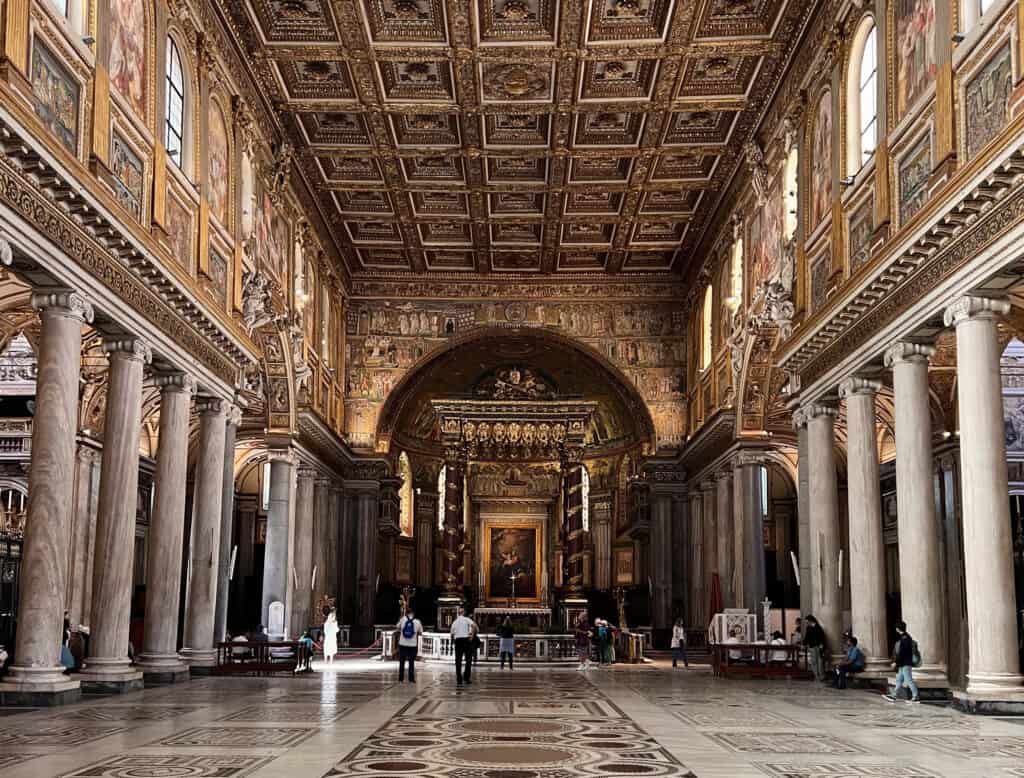
Roman Christians now had a double mandate: they had to promote their city’s supremacy as well as their faith. Besides developing the role of St. Peter, they adopted symbols of authority from ancient Roman traditions. For example, the popes appropriated the title of Pontifex Maximus from pagan priests. They built their churches in the form of basilicas, the old imperial courts of law and symbol of authority. And they exploited the city’s reputation: the center of the ancient world would become the center of the Christian church.
Early Christian Churches in Rome
Christians before Constantine had to keep a low profile, and – in spite of claims otherwise – there is no concrete evidence of any permanent churches in the city before the fourth century. Congregations met in rented spaces or private homes; these would later be listed as tituli and are often referred to as “house churches”. Many structures built later were associated with the tituli without necessarily occupying the same sites.

Constantine encouraged church construction across the empire. In Rome, he founded the famous Papal Basilicas: St. Peter’s, St. John Lateran, St. Paul Outside the Walls, and St. Mary Maggiore. However, the basilicas fell victim to centuries of looting, fires, and remodels. With the exception of Santa Maria Maggiore, only the smaller and less prominent churches retain much of their original structure. Most of them lie in areas which were depopulated during the Middle Ages.
Monti
Santa Pudenziana
Although its origins are still being investigated, this is likely the oldest continuously-used church in Rome. Fragments of a structure on the site date back to around 175 BCE. At some point, a residence was built over it which was later transformed into a bath-house. The Roman domus (home) was listed as one of the original tituli, leading to a legendary account of the owner, a senator named Pudens, and his virgin daughters Pudenziana and Prassede. Allegedly, the sisters washed the bodies of Christian martyrs and collected their blood in a well.

In the fourth century, the existing structure was transformed into a basilica dedicated to Pudenziana. Most of what remains is a mixture of renovations and restorations over the centuries, with a mosaic in the apse dating to roughly 390.
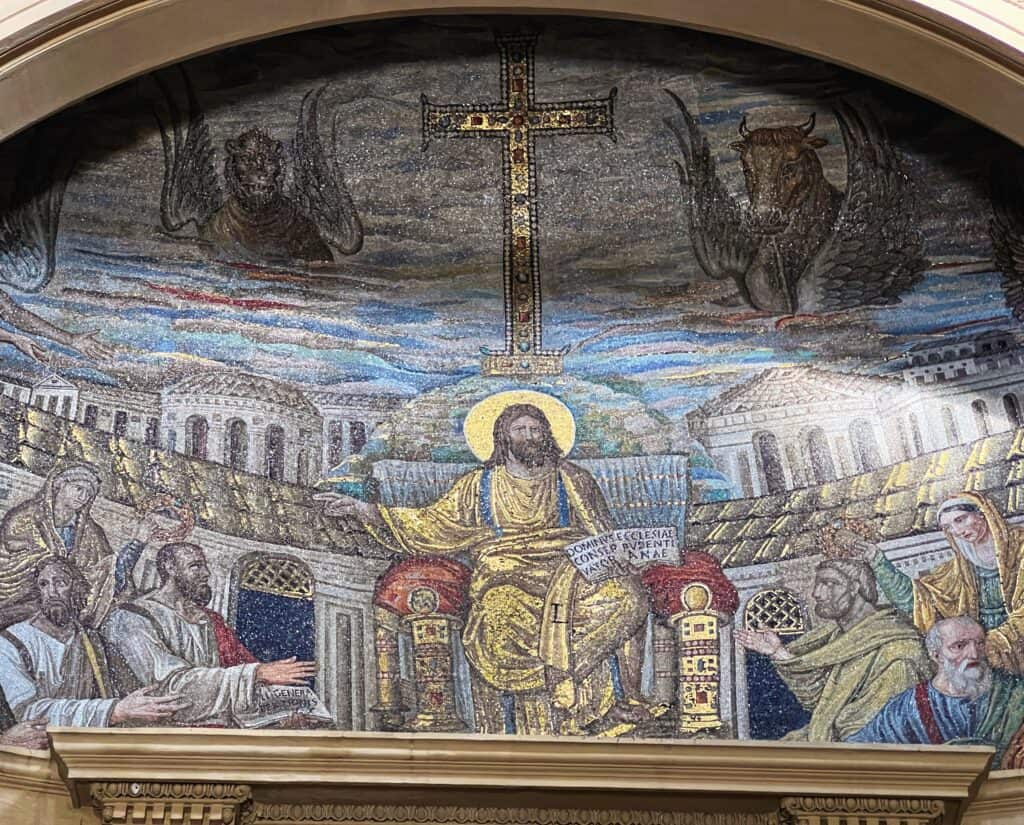
Looking at the San Pudenziana mosaic, the continuity between Imperial and Christian Rome is unmistakable. Early depictions generally represented Christ symbolically, for example as a lamb. Here he is not only human but seated on a throne, wearing senatorial garb and posed as a classical Roman teacher. His flowing hair and beard echo depictions of Zeus/Jupiter, and the imperial staff has become a cross. The post-Constantine emphasis on the authority of Christianity was underway.
Via Urbana 160, Tuesday-Sunday 9-11:30
Santa Prassede & San Zeno Chapel
Pope Paschal commissioned the Santa Prassede in the ninth century; the adjoining San Zeno chapel is a mausoleum for his mother. Amongst other relics, the church purports to hold the remains of Prassede and Pudenziana, as well as fragments of the sponge they used to wash the martyrs – and the well where they deposited the blood.


Behind its unassuming façade, the Santa Prassede hides some of Italy’s most spectacular early Christian mosaics. Both the apse and the San Zeno Chapel are plastered with meticulously crafted scenes using imperial symbolism to promote Christianity. For instance, the apse shows Christ receiving a Roman-style wreath of victory, and the martyred sisters are depicted as Imperial princesses.
Santa Prassede: Via di Santa Prassede 9a, daily 10-12 & 4-6
Celio
Santi Giovanni e Paolo & Case Romane del Celio
Along one of the oldest streets in the city, a fourth-century church sits on top of Roman ruins which themselves show significant evidence of early Christianity in the city.

Around the late fourth or early fifth century, a church was founded on the site, possibly by the senator and prominent Christian St. Pammachius. However, the structure suffered during sacks of the city, and one historian writes of late seventh century monks “squatting” in the ruins. Rebuilt in the 12th and 13th centuries, the church’s exterior is mostly Romanesque in style. Heavy remodeling left a Baroque interior, frequently used for weddings.

The Case Romane del Celio consists of three imperial-era homes, one of which includes evidence of Christian worship. Most notably, it has a fourth-century fresco cycle which appears to depict the arrest of three Christian martyrs – if so, it’s the earliest extant depiction of any martyrdom. Supposedly one of the homes belonged to Giovanni and Paolo, a pair of martyred brothers/soldiers/officers/eunuchs (depending on the account).
Piazza dei SS. Giovanni e Paolo. Basilica: daily 8:30-12 & 3:30-6; Case Romane: Wednesday and Friday-Monday 10-4, €8
Santi Quattro Coronati

Traditional histories date the Quattro Coronati to the reign of Pope St. Miltiades from 311-314, making it older than Constantine’s churches. Coronati means crowned, a reference to martyrdom. In spite of some confusion over the years, consensus now identifies the four saints as sculptors drowned by Diocletian for refusing to carve a pagan statue.


The church contains pieces from the fourth century, although the structure was rebuilt as an abbey by Pope St. Leo IV (847-855). All but the apse was burned in the 1084 Norman sack of Rome. The complex also includes a medieval cloister and garden, as well as beautiful 13th century frescoes in the Chapel of St. Sylvester.
Via dei SS Quattro 20, 6:30-12:45 & 3:30-7:45
San Clemente
Even by Roman standards, San Clemente compresses an impressive amount of history into a single site. The 12th century church covers a 4th century basilica which in turn rests on an ancient temple.
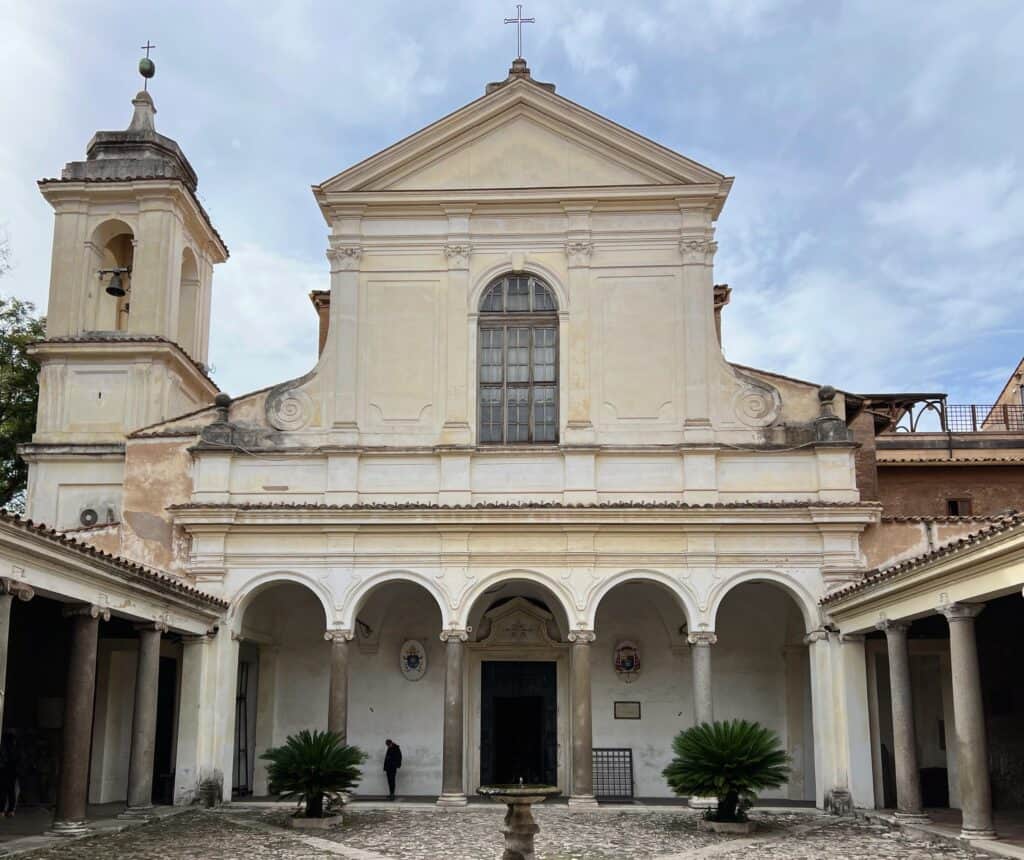
Amongst the layers, San Clemente managed to preserve the original church’s layout with an atrium-style courtyard in front. (Note that the modern entrance to the church is through the side.) In Roman times, the open space of an atrium served as the focus of communal life in a home. Early Christians transferred the idea to churches, creating an area for meetings, selling food and devotional objects, and socializing. Later, courtyards surrounded by covered walkways would evolve into monastic cloisters. San Clemente’s atrium incorporates a dozen granite columns looted from an ancient Roman structure.


Sometime between 395 and 417, the site’s original Mithraic temple was filled with rubble and used as a foundation for a basilica. The buried church contains numerous recylings of ancient Roman materials, from the marble columns to a pagan sarcophagus. Frescoes were added between the 7th and 11th centuries.
The present church was erected shortly after the Norman sack of Rome in 1094. Like the layer beneath it, the new structure borrowed the ancient Roman technique of fitting colored stones together to make a patterned floor.
Entrance on Piazza San Clemente. Monday-Saturday 10-12:30 & 3-5:30, Sundays 12:00-5:30. Admission to the excavated areas €10; purchase tickets on website.
Basilica di Santo Stefano Rotondo al Celio

One of Rome’s more mysterious structures lies hidden behind brick walls, sandwiched between the Parco Celio and a huge hospital complex. While its sensationally gruesome cycle of frescoes tends to draw the most attention, the building itself is a standout even in a city filled with remarkable architecture.


Rome’s first round church, Santo Stefano was thought to have originated as a pagan temple. With no written documentation of the basilica’s founding, it’s unclear how the fifth century structure initially functioned. An unprecedented floor plan combined four nesting circles topped by a Greek Cross. A chapel dedicated to the saints Primo and Feliciano was added in the sixth century, and its Byzantine-style mosaics are still intact.
Decorations were lavish but construction was shoddy. Santo Stefano underwent drastic remodeling to prevent a complete collapse in both the 12th and the 15th centuries. Only the two central rings of columns remain today, with the outer set embedded in a wall.
Via Santo Stefano Rotondo 7. Tuesday-Sunday 10-1 & 3:30-6:30 in summer, 10-1 & 2-5 in winter. Visiting information is on the website.
Around the Aventine
Santa Sabina

Constructed between 422 and 432, this basilica managed to retain its original colonnade and layout. More significantly for modern visitors, it’s also been stripped of later embellishments, leaving a remarkably elegant interior.

Erected over the remains of an imperial house in the affluent Aventine hill neighborhood, the church incorporates second-century columns thought to be salvaged from the nearby Temple of Juno. The Vitruvian proportions, large windows, and unbuttressed walls are hallmarks of classical Roman architecture.


The portico doors are perhaps the most significant feature of the basilica. Not only is it rare for wood to survive so long, but the carved panels include the earliest known depiction of the Crucifixion.
When Rome’s aqueducts stopped working and the city’s population declined, the Aventine hill was largely abandoned. In the 10th century, the basilica was converted into a fortress by noblemen who controlled the papacy during its most corrupt phase. After a brief stint as a palazzo, it was restored in the 12th century as part of a monastery. Other than a 1559 fresco to replace the apse’s lost mosaic, the church remained largely unaltered until a major restoration of the early 20th century.
Santa Sabina: Piazza Pietro d’Illiria 1, Tuesday-Saturday 8-7 & Sunday-Monday 12:30-7
San Nicola in Carcere
The San Nicola in Carcere may not be the city’s oldest church, but its incorporation of ancient Roman temples is notable. In Republican times, the site held a fruit and vegetable market, the Forum Holitorium, conveniently located next to the Forum Boarium, or meat market.

Three temples were erected in the second century BCE and rebuilt during the reigns of Emperors Augustus and Hadrian. The oldest and smallest temple, on the southern end, was Doric in style and probably dedicated to Spes, a personification of hope. The other two temples were built in the Ionic style. The largest, in the middle, was likely dedicated to Juno Sospita, the protectress of births. On the northern end, the best-preserved temple is thought to have been dedicated to Janus, the god of transitions.
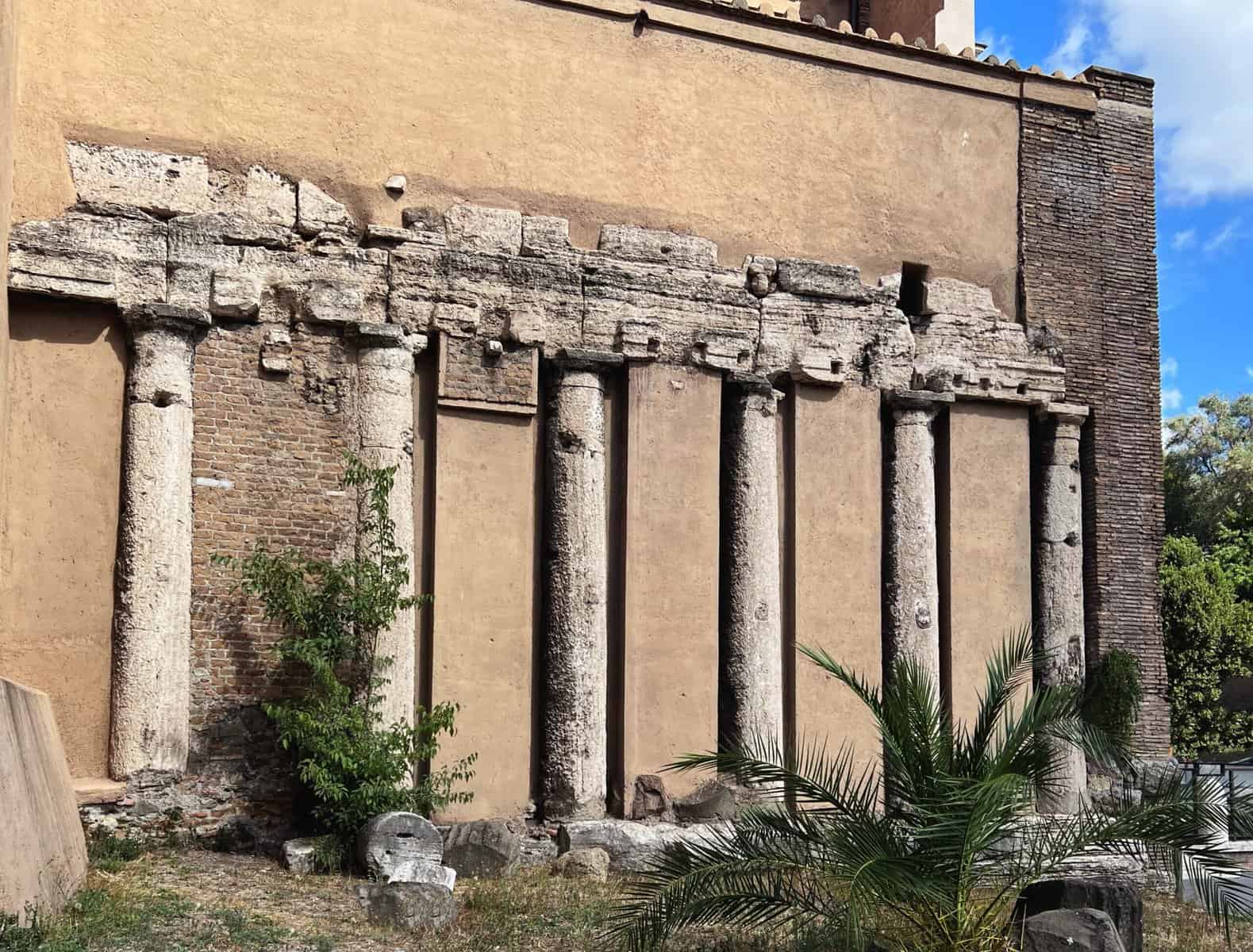
Portions of all three buildings were used in the construction of a church around 550 CE. The new basilica covered the entire middle temple, with columns from the other two temples embedded in the wall on either side. It’s one of the more striking examples of Christians reusing ancient Roman structures, although we may never know the exact motivation. Access to high-quality materials would certainly be a factor. Taking over older sites of worship also provided continuity for the community, even as it allowed the monotheists to bury pagan history.
At some point the site became associated with a jail (carcer), while the dedication to Nicola comes from the Byzantine community who began to dominate the area in the sixth century. Stairs under the altar lead to the crypt and to the base of the former Roman temples. Giacomo della Porta added the Mannerist facade when the church was rebuilt in 1599.
Via di Teatro di Marcello 46, daily 7-12:30 & 4-7
Santa Maria in Cosmedin
Built over the ultra-ancient Ara Maximus, or Great Altar dedicated to Hercules, the Santa Maria in Cosmedin is probably Rome’s oldest continuously-used place of worship. Christians may have occupied the site as early as the third century, but the earliest records mention it as a diaconia, or ecclesiastical welfare center. Pope Gregory the Great apparently used it to distribute food in the sixth century.


A rebuild followed in 782, when the church was taken over by Byzantine monks fleeing iconoclast persecution in Constantinople. The Eastern Church influenced the design, with the inclusion of three apses as well as an upper gallery for women called the matroneum. Such features can still be seen in churches all over Italy, especially in places where Byzantines dominated.
Visitors to the church do not need to wait in the long line outside, which is for those who want to pose with the Bocca della Verità (Mouth of Truth) in the vestibule. For more information on the site’s ancient Roman history, see our post on the Forum Boarium.
Piazza della Bocca Della Verità 18, daily 9:30-6
Trastevere
Santa Maria di Trastevere
Traditionally, this was the first church in Rome to openly celebrate Mass. According to legend, it was built just after the death of Pope St. Callixtus in 222; scholars think it was probably built during the pontificate of Julius, from 337-352.
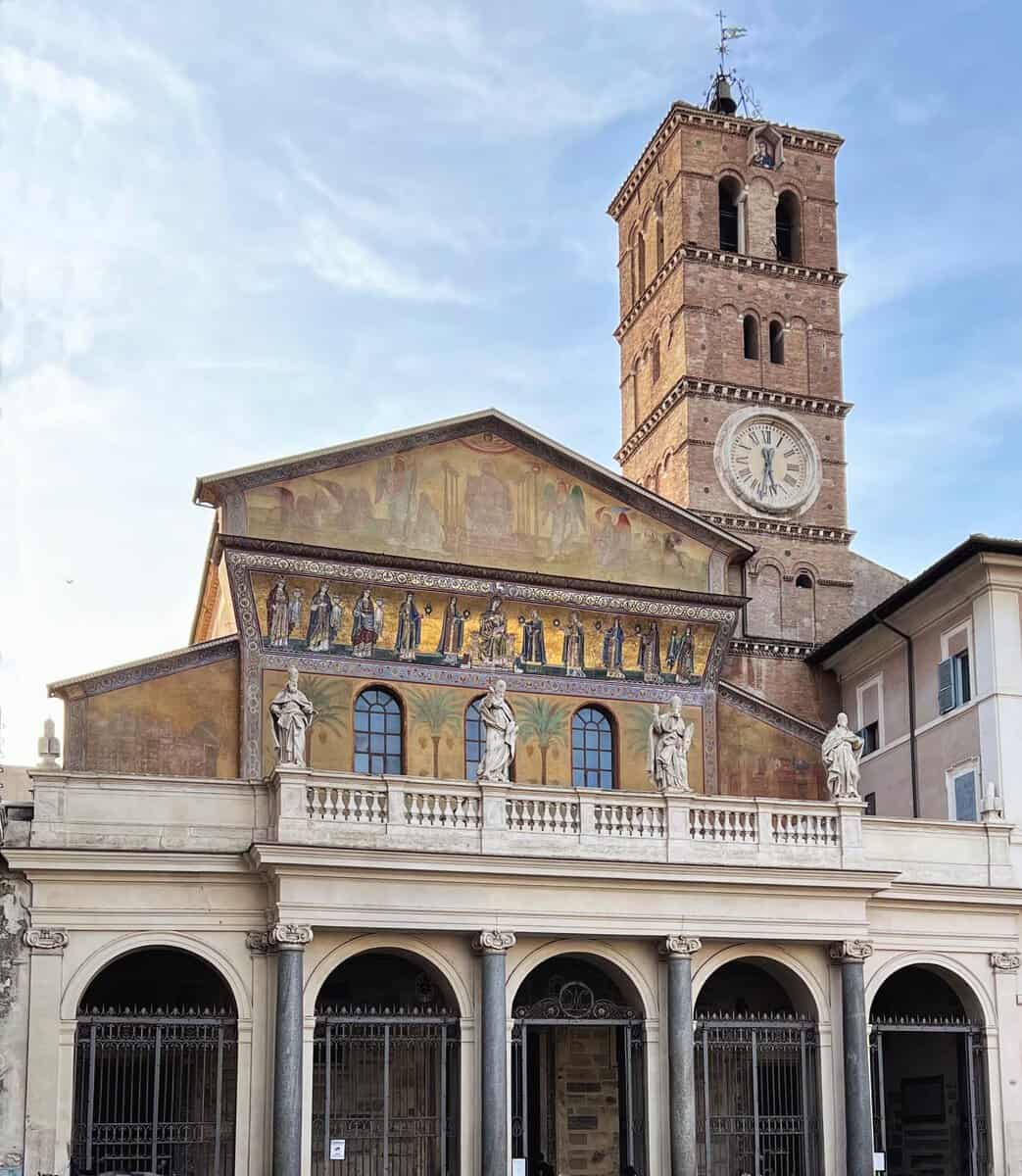
The portico in front shelters an array of fragments from inscriptions, carvings, and frescoes, some of which were collected from tombs on the Appian Way. One of the sarcophagi has a lion, which would become the symbol of Trastevere.

Unlike most basilicas, this one doesn’t have arches along the nave. Its reconstruction in 1140 incorporated enormous columns taken from the Baths of Caracalla, and putting arches on top of them would have made the church too tall. It’s still possible to discern carvings of pagan deities on the capitals and bases of the columns.
The church’s mosaics date to the 12th and 13th centuries. However, the Sacristy holds a pair of first century works from Palestrina depicting birds and a seascape.
Piazza di Santa Maria in Trastevere, 7:30am-9pm
Santa Cecilia in Trastevere
This layered site holds a church dating to the ninth century, built over a fifth-century baptistery which was itself a conversion from an ancient Roman home and bath-house. According to legend, the latter was the scene of Saint Cecilia’s grisly three-day martyrdom. Although she became known as the patron saint of music in the 15th century, Cecilia was originally known as the protector of eyesight – a role inherited from the pagan cult of the Bona Dea, or Good Goddess.


Records and archaeological evidence of the church go back to the fifth century. Pope Pascal commissioned the new building during his campaign to house Christian relics within the safety of the city walls. Not a lot remains from his time, other than the apse mosaic which, like its counterpart in the Santa Prassede, features Jesus in an imperial toga and virgins dressed like Byzantine princesses. (The church contains some notable later work, such as Stefano Maderno’s extraordinary Baroque sculpture of Santa Cecilia.)
Before entering the church, visitors pass through a courtyard filled with rose bushes and a small pool. Originally it was the atrium, surrounded by columns. Dominating it is an immense, ancient marble urn with two handles, like the vessels Greeks used to hold wine during rituals. It’s unclear how the cantharus came into the Pope’s collection or why he had it placed in front of the church. Perhaps it was used for ablutions, since Christian fountains are also called cantharus.
Piazza di Santa Cecilia. For visiting information, see the website.
Further Reading


The first few chapters of John Julius Norwich’s book Absolute Monarchs: A History of the Papacy give an overview of Christianity’s early years in Rome.
For more on early Christian mosaics, see our post Italy’s Most Stunning Mosaics From Rome to Ravenna to Sicily.
For more on Rome, see our other posts:
A Guide to Ancient Architecture in Rome
The Pantheon and the Domes of Rome
A Guide to Michelangelo’s Architecture in Florence and Rome
Celio: Rome’s Best Neighborhood Hidden in Plain Sight

